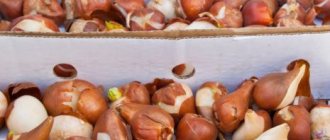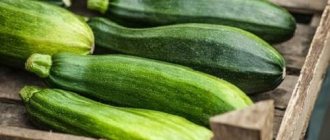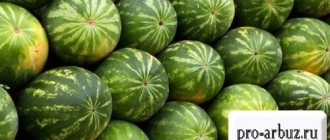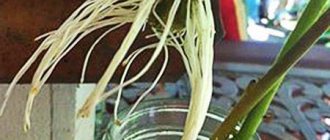It is important not only to know how to grow and harvest Jerusalem artichoke, but also how to properly store it at home in winter in order to preserve all its beneficial properties.
We will tell you how to properly store it in the refrigerator, cellar, in dried form, as well as what preparations to make for the winter from Jerusalem artichoke.
When to dig Jerusalem artichoke
With the onset of autumn, it is worth harvesting part of the crop that is already ripe and ready to eat. Experienced gardeners do not recommend collecting everything at once. The plant is surprisingly frost-resistant. Even at -40, it is perfectly stored in the ground. But problems may arise in the cellar. It will be difficult to maintain it until March. So, why complicate your life?
If it is not possible to wait until spring, it is advisable to dig the tubers in late autumn, no earlier than the end of October - mid-November . Before this, the earthen pear must ripen and accumulate well-known beneficial properties. The sooner you harvest the tubers, the less benefit they will bring.
It is important to choose the right time for excavation work. Slush is a bad help in this matter; you need to do it before frost, which can simply complicate digging.
How to dig
We need to prepare for the autumn harvest. Ten days before the planned event, the shoots are cut off, leaving only 20 cm above the ground and left to ripen in this state for another two weeks. Then everything is simple. The technology is the same as when harvesting potatoes.
You can leave the bush and a few tubers; in the spring you will be pleased with their size and juiciness. Just dig it up before the soil warms up so that the new crop does not begin to grow.
When leaving the root crop to winter, cover it with hay, or keep the stems up to one and a half meters high. This will protect from excess moisture, severe frosts, and other troubles.
Surprisingly, in favorable conditions, from one bed there is a chance to collect up to 10 kg.
Where to buy Jerusalem artichoke
Jerusalem artichoke here is more of a gastronomic exotic than a familiar product, so you cannot buy it in the vegetable department of the nearest thrift store. However, Jerusalem artichoke is available for sale, and if you set your mind, it is not so difficult to find it, especially during the tuber digging season. Where can I buy Jerusalem artichoke?
- Stores with eco- and organic products. The beneficial properties of Jerusalem artichoke have long attracted the attention of advocates of a healthy lifestyle.
- Vegetable rows of food markets, farmer's fairs.
- Private message boards on the Internet (for example, Avito). Through them, private farm owners often sell surplus crops.
- Hypermarkets, premium grocery stores.
But the best thing, of course, is to simply grow Jerusalem artichokes in your dacha. Planting material can be purchased either from private traders at the already mentioned online flea markets, or you can contact the supplier by asking a question on some popular gardening forum.
Preparation for storage
Before storing Jerusalem artichoke for a long time, it is necessary to properly prepare it. The roots of the wild tuberous sunflower (as Jerusalem artichoke is sometimes called) are harvested on a dry, cool day. The process is reminiscent of digging up and collecting potato tubers. It is better to use a pitchfork or shovel. Unlike potato root vegetables, the underground Israeli artichoke - another name for Jerusalem artichoke - has a thin skin, which is important to keep intact. Otherwise, tubers that are damaged must be eaten first.
Useful properties of Jerusalem artichoke
Jerusalem artichoke tubers are rich in B vitamins, especially a lot of B1. It is useful for the nervous and digestive systems, maintaining heart function.
They also contain a lot of vitamin C, which is responsible for the normal functioning of the immune system.
Tubers also contain a lot of potassium, calcium and zinc. They are loaded with antioxidants. And, of course, Jerusalem artichoke contains a lot of fiber, which stimulates digestion.
Jerusalem artichoke flowers have the same healing properties as the leaves.
Optimal storage conditions
When storing Jerusalem artichoke, certain requirements for temperature, humidity and light must be observed. This will allow you to fully preserve the valuable properties of root crops.
Temperature
It is recommended to store Jerusalem artichoke at home at a temperature of +4 to -1 degrees Celsius.
Humidity
The optimal humidity level for storing Jerusalem artichoke is 85%.
Illumination
Root vegetables must be protected from sunlight.
Is it possible to eat Jerusalem artichoke in the summer? At what time is it harvested for consumption?
There is no need to rush to harvest the entire earthen pear harvest.
Tubers do not have a long fresh shelf life. Without changes, they can be stored for 1 month. After this, their appearance, chemical and biological composition changes, moisture is lost, and rotting begins. They cannot be canned or dried. The solution is that the tubers do not lose their medicinal properties and appearance when overwintering directly in the beds. In the soil under snow or a small layer of dry soil, they can withstand air temperatures below -30 degrees. We need to use this opportunity to preserve the harvest. Therefore, the best solution would be to remove some of the tubers in late autumn (after the first frost), and leave the other part to overwinter in the soil, sprinkled with a layer of dry soil or snow on top.
Is it possible to collect earthen pears in the spring? In the spring, for food, the crop can be harvested as the ground thaws and in the amount necessary for food for a week, a maximum of two. You should try to dig up the entire remainder of last year’s harvest before the tubers begin to overgrow, when the new growing season of the plant begins. The main thing is not to miss the deadline. The dug up tubers are immediately used for spring planting.
Reference! Experts believe that tubers left to overwinter in the soil have a better taste in the spring compared to the taste of tubers harvested in the fall. But the sweetness is felt stronger.
Step-by-step instructions for digging up tubers
The following scheme for digging up tubers is recommended:
- From the beginning of October (or even from mid-September), dig up useful roots for preparing salads and other dishes according to family needs.
- In late autumn, harvest part of the crop for food or animal feed for 1.5-2 months.
- From late autumn until spring harvesting, use wintering tubers (if they can be easily dug up). In winter, the body simply needs vitamins!
- In spring, vitamins are needed even more due to the inevitable seasonal vitamin deficiency of the human body. Therefore, a bed with natural vitamins in the garden will be a great help to health that has weakened over the winter (you will find out what exactly the benefits of Jerusalem artichoke root are for the body and human health here).
Jerusalem artichoke is collected in this way:
- Before harvesting Jerusalem artichoke, you need to cut off all its bushes throughout the entire area. Regardless of whether part of the crop will remain under the snow until spring or not. Leave a stump 30-40 cm long from the stem of each plant. This shoot will serve as a guide for subsequent actions to dig up tubers in the fall or spring. The shoot will probably almost rot by spring and will not help in extracting tubers even from loose soil, but it will indicate exactly where they are.
- Then it’s a matter of technique, well known to everyone from many years of experience in harvesting potatoes. You can dig with shovels, but it’s more convenient to do it with a pitchfork. The forks should not have too wide a space between the teeth (Jerusalem artichoke tubers are much smaller than potatoes). It is easier to dig with a pitchfork, and the tubers are less damaged when working with such a harvesting tool.
The tubers are placed in buckets or small boxes and then transferred to a place of permanent storage. If the soil is dry during harvesting, then drying the crop is not necessary. In case of wet soil, it is necessary to dry the Jerusalem artichoke before storing it. But under no circumstances should you wash the tubers!
From special publications by our experts devoted to the use of such a useful vegetable - the earthen pear, you can learn about how it is used in dried form, how its flowers are used and syrup is prepared from the root vegetable, and we will also tell you what benefits and harm Jerusalem artichoke can bring body.
Cellar vegetable storage
An excellent place to store root vegetables is a burial pit. The temperature regime (+3°) in the cellar is optimal for this. To make optimal storage conditions you need to:
- Prepare containers, preferably wooden boxes, place Jerusalem artichokes there, layer them with sand and sawdust mixture, etc.
- Place in bags, sprinkle with soil.
- Make a paraffin (wax) protection by covering each root vegetable with a shell.
Advice: when storing, do not completely free the tubers from the ground. The soil cover retains its integrity and its vitamin content is better. It is also worth leaving the root system with the base of the stalks, about 15 centimeters long.
How to store in the cellar in winter
The advantage of storing in the basement is that this method does not require lengthy preparation. But the shelf life will be short. There are several options:
- The tubers, without shaking them off the ground, are placed in wooden or plastic containers, covered with peat or dry sawdust on top.
- First, the root crops are lubricated with clay, allowed to dry, placed in a bag and carefully tied so that air does not penetrate.
Sometimes you need to check that there are no signs of rot on the Jerusalem artichoke. The temperature in the basement should not be higher than +5°C. The shelf life in this case is about a month.
Storing Jerusalem artichoke tubers
The best way to store tubers is in soil during the winter. Unlike potatoes, Jerusalem artichoke has a thin, delicate skin, which is inevitably damaged during harvesting. Therefore, after digging it can be stored for no more than two months at a temperature no higher than +5 degrees.
But on the other hand, tubers are preserved remarkably well in the ground, and those that have overwintered become even tastier, and after thawing they completely retain all nutritional and taste qualities, as well as growth properties.
The yield of tubers harvested in the spring is 10-15 percent higher than those collected in the fall. Another feature of Jerusalem artichoke is that the plant’s vegetation continues through the stems until they dry completely, and then through the sap of the stolons. Jerusalem artichoke grows in one place for 4-5 years, that is, there is no need to plant it in subsequent years - just cultivate and harvest it.
Trench method
This method is suitable for those who have nowhere to store it in the house, no cellar or space in the refrigerator, for example.
Storage in trenches is an approach to the natural conditions in which Jerusalem artichoke grows. The disadvantages are rodents that can enter the trenches and spoil the crop . In this case, you can add poison, or place burdock inflorescences next to the tubers.
The trench should be prepared in the fall, while the ground is soft enough. Its depth should reach 50 cm. The bottom is covered with straw or sawdust. Good, undamaged fruits are placed at the bottom of the hole and covered with earth, sand, and straw. Cover with film and add another layer of earth.
The earthen pear will be stored until spring.
Storing Jerusalem artichoke in the cellar and beds
If a large harvest is harvested, it is convenient to store it in the basement in plywood boxes. The fruits are carefully placed in containers, sprinkling each row with sand or sawdust (wet). For storage, bags made of thick fabric are also used; tubers are placed in them, generously sprinkled with sand or wet sawdust. The air temperature in the basement should not exceed +4°C, and the humidity in the room should not exceed 80%.
Before laying, you can cover each tuber with paraffin, melted in a water bath. After this treatment, the vegetables are placed on shelves in the basement.
If there is no cellar or basement, then part of the harvest is left in the ground, sprinkling the plants on top with branches and soil. In this case, the question of how to preserve Jerusalem artichokes during the winter will no longer be necessary. Vegetables overwintered in this way will become softer and sweeter by spring. In warm winters, you can dig up the required amount of fresh Jerusalem artichoke at any time.
For long-term storage, a hole previously dug on the site is also used; you should choose a dry place on a hill. The tubers are placed in several layers in a hole and carefully covered with straw or sawdust. You can dig a trench in the ground and fill the bottom with branches for insulation. In winter, such storage must be covered with snow.
In the spring, when the ground thaws, vegetables can be dug up in the required volume at any time, but only before the start of a new growing season for the plant.
Apartment maintenance
The lack of a cellar or basement is not a reason to be upset. There are options for storing at home:
On the loggia
A glazed loggia and even an unglazed balcony will be a refuge for Jerusalem artichokes. It is placed at the bottom of the containers, poured using an accessible layering method from what is at hand: sand, sawdust, straw, paper, etc. If necessary, it is additionally insulated with old things. For at least 60 days, Jerusalem artichoke will not lose its properties.
Tip: before storing for any storage, Jerusalem artichoke is dug out immediately and quickly placed in a container. Otherwise, sunlight and excessive heat will destroy it.
Waxing
This method will allow the tubers to remain juicy for a long time. It is important to carry out the procedure as quickly as possible - Jerusalem artichoke does not tolerate prolonged heating.
The tubers are cleaned of soil so as not to damage the skin. An earthen pear is dipped into the prepared paraffin and left to dry. In this case, the procedure is carried out in a cold room - this will allow the fruits to cool down and not overheat.
The processed tubers are sent to be stored in the refrigerator or basement. In this form they can lie for a month.
In a glass jar
Glass containers are used to store dried or salted Jerusalem artichoke. This method is not used for fresh root vegetables that have not been processed.
In a refrigerator
In small quantities, the vegetable can be safely stored in the refrigerator. To do this you need:
- Wash each tuber thoroughly.
- Remove excess moisture from the earthen pear.
- Place in plastic bags or use airtight containers.
- Store in vegetable drawers for approximately 21 days.
Jerusalem artichoke is not afraid of freezing, thawing and re-freezing. Therefore, it is cut into pieces or grated and stored in portions in the freezer. When necessary, defrost gradually by placing it in cold water or simply putting it in the refrigerator first, then at room temperature.
Jerusalem artichoke tubers, reminiscent of ginger root, can be cooked either with the skin or peeled. Rubbed with the skin - they acquire a gray tint, but retain the maximum amount of silicon and iron located under the skin and in it itself. Peeled pieces look more presentable, but some of the beneficial properties are lost.
It is recommended to place the vegetables in cold water before peeling, and then remove the peel with a knife that does not lead to oxidation processes (made of wood, stainless steel, bone, etc.). If you plan to puree the vegetable, then first place it in acidified water (with lemon or vinegar) for a short time so that the flesh does not darken. Then the fruits are transferred to a colander so that the water is completely drained.
Is it possible to freeze at home in the freezer?
Freezing is one of the easiest ways to preserve Jerusalem artichoke for the winter in an apartment. Before putting the Jerusalem artichoke in the freezer, the root vegetables are washed, peeled, cut into cubes and placed in a bag or a special food container. Freezing will preserve the beneficial properties of the fruit for 3 months.
To defrost the product, you need to immerse the cubes in cold water. If you immediately heat the product, the Jerusalem artichoke can turn into mush.
Some people store Jerusalem artichoke in the refrigerator for no more than 3 weeks. You need to carefully peel the fruits and place them in hermetically sealed plastic containers.
How to freeze at home in the refrigerator?
Ground pear can be frozen in different ways:
- entirely;
- in pieces;
- grated on a grater.
It is placed in the freezer immediately after washing or blanched. Moreover, you can blanch with steam, in water or in whey. It all depends on what you will cook later.
Methods
- Just freezing.
- Blanching with water or in milk curd whey.
Advice
Reference! Blanching is immersing the product for a few seconds or minutes in boiling water or another solution. You can also do this over steam. The product is then cooled in ice water or in air. Blanching is very good before freezing. With this preparation, root vegetables retain their color and shape.
You can freeze any fresh root vegetables. Suitable for damaged ones and those with dark spots.
Preparation
Root crops:
- Select suitable ones.
- Wash, clean.
- Cut into small cubes or noodles.
Inventory for different freezing methods:
- Pot.
- Colander.
- Silicone mat.
- Storage container.
Easy way
- Place washed, dried, chopped or grated root vegetables in a plastic bag, release the air and put them in the freezer.
- Another option: carefully place chopped or grated vegetables on a silicone sheet, freeze them, then pour them into a container and leave them for long-term storage.
For storage in the freezer, you can use any small container suitable for freezing.
Blanching
You will need:
- Pot.
- Colander with handle.
Important!
Interesting! When blanched in whey, the vegetable develops a slightly sour, pleasant taste.
Blanching freezing process:
- Pour whey or water into the pan.
- Heat to 100 degrees.
- Place root vegetables cut into cubes or noodles in a colander.
- Lower the colander into the pan so that the cut pieces are in the liquid.
- Secure a colander to the pan.
- Blanch for 9-10 minutes.
- When finished, remove, cool, and let dry.
- Place in a container or any container suitable for freezing food.
Serve in portions as needed for consumption at a time.
Preparations for the winter
Ground pears make delicious preserves, jam, as well as pickled and fermented preparations.
Jerusalem artichoke winter salad
Ingredients
- Ground pear tubers - 1 kg;
- Carrots – 0.5 kg;
- Salt;
- Lemon – 1 pc.
How to prepare Jerusalem artichoke for the winter
How to make a winter salad
- We cut carrots and Jerusalem artichoke tubers.
- Three lemons on a grater.
- Mix chopped vegetables with lemon mixture and add salt.
When the mixture releases its juice, put the salad into jars and pasteurize them for about half an hour.
Pear jam
Ingredients
- Pumpkin pulp - 1 kg;
- Jerusalem artichoke tubers – 1 kg;
- Lemon – 1 pc.;
- Granulated sugar - 250 g.
How to make Jerusalem artichoke jam
- Chop the tubers and pumpkin pulp.
- Three lemons on a grater.
- Mix all the ingredients and wait for the mixture to infuse.
- Place the mixture on the stove and after boiling, cook for five minutes.
- Pour hot jam into jars.
We cover the jars with a blanket, and after 24 hours we put them away for storage in the cellar or refrigerator.
Jam
Jam is no less tasty and healthy. To prepare it you will need:
- 1 kg of pear root vegetables;
- 500 g plums of any kind;
- 100 g sugar;
- 100 ml water;
- 5 g citric acid.
The culinary process is very simple. Necessary:
- Wash the plums and remove the pits.
- Rinse the Jerusalem artichoke thoroughly with a brush and, without peeling, cut into thin slices.
- Place all ingredients in a bowl and mix them with water and sugar.
- Bring to a boil over low heat, remembering to stir constantly.
- Boil covered for an hour, stirring the mixture regularly.
- Cool the prepared jam slightly and rub it through a strainer so that the plum skins are easily separated.
- Boil the ground mass with the addition of citric acid over low heat for 10 minutes.
- Transfer to sterilized jars and seal with airtight lids.
Fermentation
To prepare a healthy fermented snack you will need:
- 1 kg of root vegetables;
- 100 g fresh dill;
- 1 liter of water;
- 60 g salt.
First of all, you need to select tubers of the same size and good quality, and then perform a series of actions:
- Wash and dry Jerusalem artichoke roots.
- Cut them into thin slices and place in a glass container.
- Alternate each layer of thinly sliced root vegetables with sprigs of dill.
- Prepare the brine by dissolving the salt in boiling water.
- Wait for it to cool and fill the jar with the ingredients with brine.
- Keep under pressure at room temperature for a week.
- Place in a cool place for later storage.
Jerusalem artichoke in marinade
Ingredients
To prepare the marinade: 2 liters of water and 800 ml of table vinegar.
For putting in jars: 1 g of coriander powder, a head of garlic and 1 kg of earthen pear tubers.
To prepare the brine: 3 tbsp. coarse salt and 2 liters of boiled water.
How to pickle Jerusalem artichoke
To pickle the tubers of this plant, follow the step-by-step recipe:
- We wash the Jerusalem artichoke tubers with a stiff brush and hydrogen peroxide and remove the tendrils.
- Place the tubers in sterile jars.
- Prepare the brine for pouring from water and salt, boiling it for 2 minutes. Remove from the stove and wait 15 minutes.
- Pour brine over the tubers, cover and put in a cool place for a week. Then drain the brine.
- Prepare the marinade: put the water on the fire and after boiling, add the coriander, pour in the vinegar and remove from the stove.
- Add garlic cloves to the jars with tubers. Cleaning and cutting them.
Pour the marinade into the jars, close and wait three days: after that you can try the pickled Jerusalem artichoke.
Marinade with pepper
Jerusalem artichoke for the winter in a spicy marinade
Ingredients for marinade:
- 900 g of Jerusalem artichoke fruits;
- chilli;
- ½ tbsp. mustard seeds;
- 2 tbsp. Sahara;
- a glass of vinegar 5%;
- 1 lemon;
- 1½ tsp salt.
Prepare the appetizer in the following sequence:
- The fruits are soaked, washed, peeled, and cut into 10mm slices.
- A 1 liter jar is washed and sterilized.
- Place Jerusalem artichoke slices in the prepared container in layers, sprinkling each with mustard seeds, and place hot pepper on the bottom.
- Prepare a marinade from water, zest, spices, and add vinegar at the very end.
- Boiling brine is poured into a jar and sterilized for 10 minutes.
- The jar of pickled Jerusalem artichoke is screwed up and, after cooling, placed in the refrigerator or lowered into the cellar.
Ingredients
- Water – 2 glasses;
- Jerusalem artichoke tubers – 1 kg;
- Sea buckthorn juice – 1 glass;
- Granulated sugar - 200 g.
Ground pear with sea buckthorn juice
How to cook Jerusalem artichoke jam with sea buckthorn juice
- Peel the washed tubers and cut into slices.
- Mix sea buckthorn juice and water.
- Fill the slices with this mixture and add granulated sugar.
- Place the mixture over medium heat and remove when it boils.
Transfer the jam into sterile jars, cover with lids and pasteurize. If the jars are 0.5 liters, pasteurize for 10 minutes, 1 liter - 15 minutes.
Powder for coffee drink
Prepared tubers, cut into thin rings, are not peeled. They are fried in the oven until brownish, and then ground using a coffee grinder or mortar. This powder is stored in an airtight glass container and then brewed into coffee. It is recommended to add milk to taste.
Using the recommendations, you can choose the most convenient option for storing Jerusalem artichoke at home without losing its qualities.
Healing recipes from Jerusalem artichoke leaves
Jerusalem artichoke leaf tea
Place 1 tbsp in a thermos. a spoonful of crushed leaves (fresh or dry - it doesn’t matter), pour 500 ml of boiling water. After 3 hours, the healthy drink is ready.
How to use. Drink 100 g 20 minutes before meals, no more than 3 times a day.
What does it help with? Strengthens the immune system, improves brain function, helps with constipation.
Jerusalem artichoke tincture
Pour 500 g of dry leaves into 1 liter of vodka and leave in a cool, dry place for 15 days.
How to use. 1 tbsp. Dilute a spoonful of tincture in 150 ml of water. Take 3 times a day.
What does it help with? Cleanses the liver, removes waste and toxins from the body.
Bath infusion
Pour 3 liters of boiling water over 10–15 Jerusalem artichoke leaves and leave for 30 minutes. Strain and pour into a bath of warm water.
How to use. Take a bath for no more than 10 minutes.
What does it help with? Joint pain, radiculitis, gout.
Dried
A large harvest of Jerusalem artichoke is ideally preserved dried. It is cut into slices and dried at a temperature of 60 ° C by any acceptable method:
- In a natural way: in a cool, ventilated, darkened room, spread out in one layer on the surface or strung on a string.
- Oven.
- Air fryer.
- Electric dryer.
- Microwave oven.
Dried vegetables should be stored in glass containers; it is better to place them on the refrigerator shelf.
Tip: before drying, it is recommended to blanch the pear slices for 10 minutes in soda or salted water, as well as in milk-curd whey (at 95°). The last option is also good before placing it on the freezer shelf.
How to dry properly
Dried root vegetables do not spoil in room conditions for up to 2 years. Preparation of the dietary supplement will take 6-10 hours. Drying is a good way to preserve mangoes.
- rinse the fruits thoroughly and remove the peel;
- cut into slices 0.5 cm thick;
- line a baking sheet with parchment paper;
- place the slices in one layer;
- dry in a slightly open oven at a temperature of 50-60° for 5 hours.
Juicy fruits may not dry out during this time. Then they are cooled and put into the oven again for 2-3 hours.
The finished dried Jerusalem artichoke is collected in glass containers with tight lids. Store in a dark, dry place without foreign odors.
Drying methods
Dried Jerusalem artichoke retains almost all the beneficial properties inherent in the root vegetable. You can prepare it in several ways - in the oven, electric dryer or naturally, in the fresh air.
On air
Drying root vegetables in air is one of the most accessible and popular methods that allows you to preserve the main properties. This procedure should be carried out within 5-7 days, which should be sunny and clear. Cloudy weather is not recommended for drying Jerusalem artichokes in the open air, since the process will be significantly delayed, and the root crops themselves risk being damaged by gnats and flies.
It is necessary to place whole or chopped Jerusalem artichoke on parchment paper and expose it to the open air. The product can be considered completely ready as soon as all the moisture has evaporated from it.
In the oven
The oven drying process is faster and can be used at any time of the year, regardless of weather conditions. In this case it is necessary:
- Line clean baking sheets with special baking paper.
- Cut the Jerusalem artichoke tubers into thin slices and place them on lined baking sheets so that they do not touch each other.
- Set the oven temperature at +50 degrees and leave for three hours. During this period, some of the water will evaporate from the chopped tubers.
- Leave the Jerusalem artichoke slices alone for one day so that they can cool naturally.
- Place the chopped root vegetables back into the oven, where they will finally cook at 60 degrees.
The result will be thin and crispy, very tasty slices of Jerusalem artichoke, which fully retain their beneficial properties.
In an electric dryer
An electric dryer is very convenient for preparing such preparations, since it is equipped with several sections and a function for adjusting the temperature level. On the dashboard you can set all the necessary parameters in advance. The device will notify you that the product is ready with a special signal.
Planting and growing Jerusalem artichoke
Briefly about the technology of growing Jerusalem artichoke.
At first glance, it is quite simple and similar to the technology of growing potatoes and, at the same time, has a number of specific features. Row spacing is 70 centimeters, the distance between plants in a row is 40 centimeters, approximately 35 thousand plants are planted on one hectare. Due to the fact that the plant is perennial and is used in industrial plantings for 4-5 years, the main costs are incurred in the first year when planting a plantation. Therefore, it is advisable, before preparing the soil (ploughing), to apply 50-100 tons of manure per 1 hectare, or complex fertilizers (NPK) at the rate of 60-90 kg of active substance per 1 hectare. Subsequently, it is recommended to annually apply 100-200 kg (in physical weight) of ammonium nitrate at the beginning of the growing season. This will help increase the yield of the crop. Planting is carried out with a two-row potato planter BOMET (Poland). Planting dates depend on the ripeness of the soil and weather conditions. Usually this is the last ten days of March - early April. The principle is the sooner the better. The Interest variety has a long growing season - 180-200 days. One of the biological features of Jerusalem artichoke is that it begins to germinate at soil temperatures above +5 °C, that is, in early spring. At this time it is impossible to enter the field, but the Jerusalem artichoke is already growing. Therefore, to obtain maximum yield, it is preferable to plant in winter. Planting can be performed with the formation of ridges directly during the operation or without ridges. The absence of ridges will allow pre-emergence and post-emergence harrowing to control weeds.
When planting in ridges, depending on the presence of weeds, you have to perform 1-2 hillings
Here it is important to perform this operation in a timely manner, which will give the plants a successful start, and then, if there are already 5-6 pairs of real leaves, the rows close and the Jerusalem artichoke is not afraid of weeds. Cultivation (hilling up) can be carried out with a row-crop cultivator KRN-5.6 with three hillers in the middle of the frame, since sowing is carried out with a two-row planter
It is possible to use a lightweight two-row hiller made in Poland. This basically completes the care work. The next stage is harvesting.
>VIDEO Jerusalem artichoke - A cure for all diseases!
How to choose the right one
Jerusalem artichoke must be chosen correctly, paying attention to several main points:
- Root vegetables are characterized by yellow, reddish and brown colors.
- The texture of high-quality specimens should be dense and elastic. Sluggish and softened root vegetables should not be purchased.
- The presence of roughness and small growths on the surface of the Jerusalem artichoke peel is normal. However, you should avoid purchasing root vegetables with wrinkled skins and pronounced spots.
- Fresh root vegetables have a light and pleasant earthy aroma.
Jerusalem artichoke harvest
Dig the Jerusalem artichokes, preferably with a fork, so you don't cut the tubers when you try to collect them. You can harvest them at any time, but Jerusalem artichokes are much sweeter and tastier after frost. You can dig them any time as long as your ground is not frozen. To prolong harvest, add a thick (50 cm) layer of mulch after the first frost. This will prevent the soil from freezing and you will have a few more weeks to harvest your earthen pears.
How long does Jerusalem artichoke last?
- Tubers can be stored in the bottom drawer of the refrigerator for a maximum of a month, and more often – 2-3 weeks. If you freeze Jerusalem artichoke, the shelf life will be 2 months, in the basement - up to 2 months.
- Jerusalem artichoke left in the ground will be usable throughout the winter. In dried form, the shelf life is one to one and a half years.
Useful articles for gardeners:
- When to harvest onions
- How to properly care for bulbous flowers
- When to remove leeks from the garden for storage
- When to dig up gladioli in the fall for the winter after flowering
- When to dig up tulip bulbs after flowering
Conditions for growing earthen pear
Jerusalem artichoke will grow well anywhere. You can grow them in any climate, in full sun to partial shade. Perennial plant in all zones.
Jerusalem artichoke is not picky about the soil; it will even yield crops quite reliably on clay soils.
They grow best in loose, fertile soil. Since Jerusalem artichokes are perennial, you need to give them their place in the garden.
It grows tall, so be sure to plant them in an area where they won't shade the rest of your crops. The north side of the beds would be ideal.
How to store Jerusalem artichoke in an apartment
Root vegetables are stored in the apartment:
- in a refrigerator;
- in the freezer;
- in a cool, dry place in the form of chips or canned food;
- on the balcony.
It is better to stick to the last option, but only if the space is not heated. Before storing Jerusalem artichoke at home in winter, choose a suitable place according to 2 criteria: temperature not higher than +5 ° C and humidity at 85%.
On the loggia
When harvesting, try to keep the tubers in their original form - do not tear the fruits from the roots, do not shake off the soil. Get rid of only vegetables that have rotted or been damaged during gardening. Do not leave it in the air or under the sun for a long time; put away the perishable product for storage.
Place Jerusalem artichokes in boxes filled with sawdust, peat, or in bags of earth. Place it on a balcony or loggia without heating. Carefully check the earthen pear periodically and remove spoiled products.
In a refrigerator
To store in the refrigerator:
- select whole root vegetables, wash carefully;
- wrap each in a damp cloth made of natural fabric;
- place on a shelf next to the freezer or in the “fresh zone” where the temperature is maintained at zero.
In this state, the earthen pear will last up to 20 days.
To prevent the fruit from drying out, wrap it in a damp cloth before storing it in the refrigerator.
In the freezer
It will not be possible to eat Jerusalem artichoke fresh after freezing - the fruits will release juice and become watery and tasteless. Tubers can be used in heat-treated dishes. The product will not lose its nutritional value and will be as healthy as in the fall.
Before freezing, the “potatoes” are sorted, washed and peeled. The pulp is crushed into pieces, the size of which depends on the requirements in the recipes. You can cut it with a knife into cubes, slices, slices or grate it.
Place small root vegetables in plastic containers with a lid or ziploc bags and place them in the freezer whole. Place the pieces on a baking sheet or suitable plate in one layer and freeze in shock mode or at maximum temperatures.
Then pour into the same bags or containers. Try to portion out and eat the container at a time. Repeated freezing is not recommended. The product can be stored at -18 °C for up to 3 months.
Canning and drying
To preserve the benefits of Jerusalem artichoke for up to a year, the product can be preserved or dried. To dry, root vegetables are washed and peeled. Immerse in cold water with citric acid, cut into thin slices and return back to the liquid. The solution will not allow the slices to oxidize and darken.
When the cutting is done, remove the plates and dry them with paper towels. Place on parchment in one layer, place in a dehydrator or oven at 60-80 °C. To avoid burning, you can turn on the convection or open the door slightly. The drying time depends on the power of the device, check and remove slightly fried chips at the stage.
Let the workpiece cool. Add spices to taste and place the dried Jerusalem artichoke into glass jars with a lid. Store in a dry place, otherwise the chips will become damp and spoiled.
The earthen pear can be preserved separately, with spices or in combination with other vegetables. For the classic recipe take:
- 1 kg of washed Jerusalem artichoke (wash with a brush, fruits with peel are preserved);
- 2 medium cucumbers;
- 2 small carrots for taste;
- 4 tbsp. l. salt;
- 2 liters of water;
- favorite spices for pickling cucumbers (bay leaves, dill umbrellas, parsley and celery roots, peppercorns are suitable).
The three-liter jar and sealing lid are thoroughly sterilized. Fill the container with vegetables and boiling water. After a minute, the water is sent to the pan, boiled again and poured into the jar. Add spices, roll up and place bottom up. For better sterilization, canned food can be wrapped in a blanket for half an hour, and then it must be stored in the refrigerator or cellar.
Preparing for drying fruits
Waxing
Jerusalem artichoke is stored longer in paraffin than without a protective layer. For processing, root vegetables are cleared of soil, washed and dried with paper towels. Try not to damage the skin, otherwise the product will rot. The treated specimens are left on the table for 2 hours so that the surface is completely dry.
At home, food paraffin is melted in a water bath or in the microwave. Each “potato” is dipped into the mixture, removed and transferred to a smooth surface. When the paraffin has hardened into a crust, the earthen pear is laid out in boxes or boxes with straw. Store in the basement, on a cool balcony or under the bed away from heating appliances.











